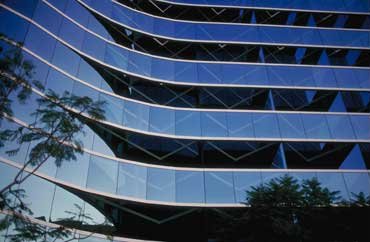High Performance Windows


High performance windows are energy efficient because their thermal loss, or U-factor, is low. Some high performance windows are called "low emissivity windows" or "low-e windows", referring to the low emission of infrared radiation (heat) due to low-e coatings on the glass. Advanced high performance windows can reduce energy losses to nearly zero, achieving energy savings that rival those of the best insulated walls.
Emissivity is a measure of the ability of a material to absorb and radiate or emit energy. Dark dull materials have high emissivity. Reflective materials like glass and polished metals have low emissivity, i.e., they are poor absorbers and emitters of thermal energy. (Specially formulated glasses, like borosilicate or "pyrex", have lower emissivity than normal glass.) This is why they feel cool to the touch compared to other materials in the same environment. However, even though glass has low emissivity, a single-pane glass window will not insulate as well as the same area of a well-insulated wall (that is, it's R-value is lower). As a result, there is considerable heat loss through the typical window.
Another way to improve a window's energy efficiency is to surface the glass with a low-emissivity (low-e) coating, an ultra-thin, practically invisible layer of metal or metallic oxide. These coatings help reflect radiant infrared energy, which helps keep it inside during the winter, and outside during the summer, adding to the low-emissivity of the glass itself. The solar heat gain coefficient (SHGC) of low-e coated windows varies. Windows with a lower SHGC reflect and keep more of the sun's heat out, which is more suitable for areas where cooling is the greater concern; windows with a higher SHGC allow more of the sun's heat in, which is more suitable for areas where heating is the greater concern.
High performance windows utilize one or both of these methods to reduce energy loss. Low-e coatings of tungsten oxide, often called electrochromic films, can even be switched from clear to tinted electronically, thereby varying the SHGC. New window prototypes using these coatings can enable windows to have dynamic solar control, providing an all-climate, all-year, solution to energy loss.
Replace single-pane windows with high performance windows. In order of increasing efficiency (but also expense) these include: